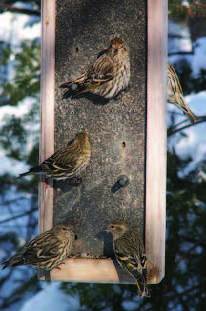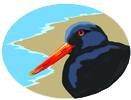
Pine Siskins are nondescript birds seen visiting here in large flocks. Their calls clue me in to their presence and leading me to look for a foraging flock in the tree tops. These flocks can be mixed with other species, such as goldfinches, juncos and crossbills.
Pine Siskins are a five-inch finch with an uncharacteristically narrow bill -- for a finch. They are heavily streaked with shades of brown with a bit of pale yellow at the base of their short, notched tail and a yellow line on their wings that is most easily visible in flight.
It is said that when it rains Pine Siskins it pours. These nomadic flocks appear in the fall and winter as birds descend from higher elevations. Flocks of fifty to two hundred are common and some reach a thousand. They will descend on bird feeders and clean them out. They feed on plant buds and seeds, such as thistle seeds. They also eat some insects, drink nectar from blossoms, and sap from the holes made by sapsckers. They are also attracted to road salts, mineral licks, and ashes.
Courtship displays begin before the winter flocks break up. The singing male will fly circles above the female. They return to the coniferous forest or to mixed forest with hardwoods to breed. Since the choice of breeding areas is based on food availability, it is not very predictable.
Pine Siskins nest semi-colonially, building their nests only a few feet apart on the outer branches. They are made of grass and rootlets lined with fur and feathers. The female incubates four to five greenish-blue eggs that are speckled brown. The male feeds the female in the nest for two weeks of incubation and later provides food for the female and nestlings.
So look up in the trees for glimpses of yellow in tight flocks.
Pine Siskins Photo by Cephas
